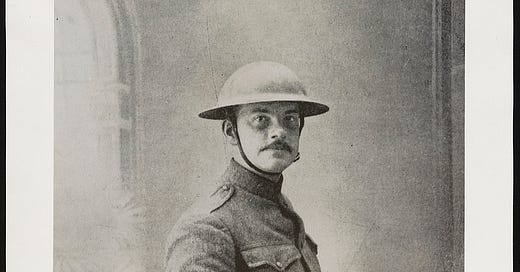Fools Like Me
The Literature of Army Veterans and America's Sense of Self. Part V: Joyce Kilmer
“The people I like best here are the wild Irish…”
One of America’s most famous poets found a home alongside the “wild Irish” boys of the New York National Guard’s 69th Infantry Regiment. When he enlisted in 1917, Alfred Joyce Kilmer, known as Joyce, was a staff writer for the New York Times and one of America’s best-known poets. His 1913 poem, “Trees”, had been a mass sensation and continued to spread across the country. Yet while it might seem unusual to us today that a literary celebrity would voluntarily sign up—at the peak of his fame—to fight in a war, it made all the sense to Kilmer. His 1916 poem “Apology”, included the lines,
Is Freedom only a Will-o'-the-wisp
To cheat a poet's eye?
Be it phantom or fact, it's a noble cause
In which to sing and to die!
Freedom, he believed, was worth fighting for, worth dying for. And if he was to fight, what unit could be better than the “Fighting 69th”, with its “Fighting Chaplain”, Father Francis Patrick Duffy?1 Filled primarily with Irish immigrants, the 69th—re-designated as the 165th Infantry Regiment—would be Kilmer’s home for the war. (Note: though it does not appear that Kilmer’s family came from Ireland, he passionately identified with that country and its fight for independence.)2
Joyce Kilmer in his 165th Infantry Regiment uniform. Source: Library of Congress.
Trees
I think that I shall never see
A poem lovely as a tree.
A tree whose hungry mouth is prest
Against the earth's sweet flowing breast;
A tree that looks at God all day,
And lifts her leafy arms to pray;
A tree that may in summer wear
A nest of robins in her hair;
Upon whose bosom snow has lain;
Who intimately lives with rain.
Poems are made by fools like me,
But only God can make a tree.
Poet Warrior
The 165th fought under General Douglas MacArthur as part of the 42nd Infantry "Rainbow" Division. It first saw combat in February, 1918, near the Rouge Bouquet part of the Parroy Forest, near the village of Baccarat. Kilmer memorialized the battle in a poem, titled “Rouge Bouquet” that has now become a regular part of regimental events.
Kilmer proved an effective soldier and leader. And he loved his unit. When offered a commission, he reportedly said he would rather be a sergeant in the “Fighting 69th,” than an officer in any other regiment.
The 165th took part in the Aisne Marne campaign of late spring and summer. On July 30, 1918, Kilmer was killed by an enemy sniper as he took part in a reconnaissance mission in the Picardy region of France. He is buried in the Oise-Aisne American Cemetery.3
Soldiers with the 165th during the attack at Landres-et-St. Georges (October 1918). Source: Department of Defense.4
Rouge Bouquet
In a wood they call the Rouge Bouquet
There is a new-made grave to-day,
Build by never a spade nor pick
Yet covered with earth ten metres thick.
There lie many fighting men,
Dead in their youthful prime,
Never to laugh nor love again
Nor taste the Summertime.
For Death came flying through the air
And stopped his flight at the dugout stair,
Touched his prey and left them there,
Clay to clay.
He hid their bodies stealthily
In the soil of the land they fought to free
And fled away.
Now over the grave abrupt and clear
Three volleys ring;
And perhaps their brave young spirits hear
The bugle sing:
“Go to sleep!
Go to sleep!
Slumber well where the shell screamed and fell.
Let your rifles rest on the muddy floor,
You will not need them any more.
Danger’s past;
Now at last,
Go to sleep!”
There is on earth no worthier grave
To hold the bodies of the brave
Than this place of pain and pride
Where they nobly fought and nobly died.
Never fear but in the skies
Saints and angels stand
Smiling with their holy eyes
On this new-come band.
St. Michael’s sword darts through the air
And touches the aureole on his hair
As he sees them stand saluting there,
His stalwart sons;
And Patrick, Brigid, Columkill
Rejoice that in veins of warriors still
The Gael’s blood runs.
And up to Heaven’s doorway floats,
From the wood called Rouge Bouquet,
A delicate cloud of buglenotes
That softly say:
“Farewell!
Farewell!
Comrades true, born anew, peace to you!
And your memory shine like the morning-star.
Brave and dear,
Shield us here.
Farewell!”
No Worthier Grave
Kilmer’s death was felt both wide and deep. He was a dedicated family man, with a loving wife Aline (also a poet) and four children (a fifth, Rose, had passed away as Kilmer was preparing to head overseas). Newspapers across the country, including the New York Times and Washington Post, ran lengthy articles extolling his poetry and writing, praising his bravery and character, and lamenting the loss.
The powr of Kilmer’s influence is still felt today. In 2023, for example, his unit, the 69th Infantry Regiment, carried his crucifix with them on a deployment to the Horn of Africa. Normally stored in a display case at the unit’s headquarters in Manhattan, the crucifix had also deployed with the unit when it served in Iraq in 2004.
His words also still move us. Though it has been a couple of years since I last visited Section 60 in Arlington National Cemetery, where many of those who gave their lives in the War on Terror are buried, I can see it in my mind’s eye. And when I do, Kilmer’s words come to me:
Let your rifles rest on the muddy floor,
You will not need them any more.
Danger’s past;
Now at last,
Go to sleep!”
There is on earth no worthier grave
To hold the bodies of the brave
Lifting up Army writers on Substack
This week we look highlight another Army writer on Substack. Stan Lake is an Army veteran who produced a film about his deployment to Iraq with the NC National Guard. Stan writes on the themes of faith, nature, war, and life.
Additional Resources:
You can learn more about this Fighting 69th here.
Be Part of Army 250
If you’d like to write a newsletter post, share an educational resource about the Army, or lift up an opportunity for people to connect with the Army (e.g., an event, story, etc.), please contact Dan (dan@army250.us).
Father Duffy remains one of the most highly-decorated chaplains in Army history. He earned the Distinguished Service Cross, Distinguished Service Medal, Legion d'Honneur and Croix de Guerre for his service in World War I. When Father Duffy died in 1932, Kilmer’s poem “Rouge Bouquet” was read at the funeral. You can find Father Duffy if you go to Times Square, New York City, where ever since 1937, his statue has stood in Father Duffy Square.
Kilmer was also, at this time, a devout Catholic. In 1913 he converted and went on to edit the book, Dreams and Images: An Anthology of Catholic Poets.
Regimental history has it that Kilmer’s crucifix was found and taken home by then-Major William Donovan. Donovan would go on to ear America’s highest military awards, including the Medal of Honor and the Distinguished Service Cross for his service in World War I. In World War II, Donovan founded the Office of Strategic Services, considered the precursor to the Central Intelligence Agency.
The appearance of U.S. Department of Defense visual information does not imply or constitute DOD endorsement. The Department of Defense [nor a respective Military Service or any other DOD Component] does not approve, endorse, or authorize this company, its products or services.








Lovely article, really enjoyed it 👍
Very powerful.
https://www.findagrave.com/memorial/3363